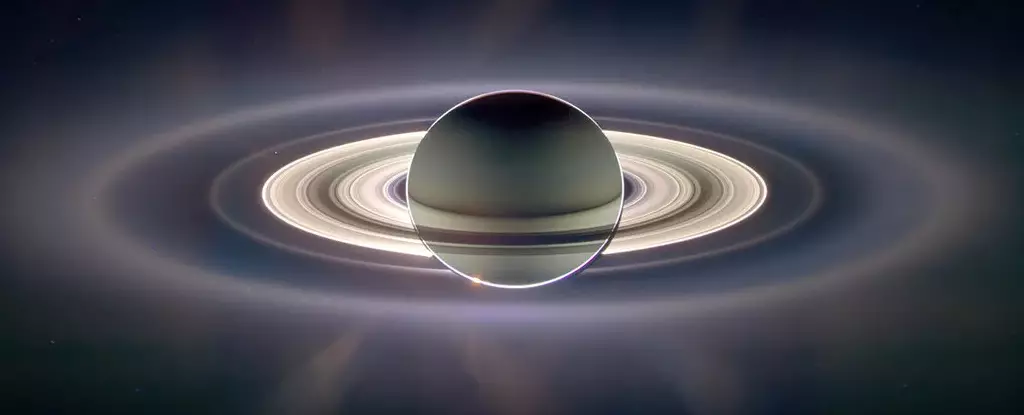Saturn’s magnificent rings are a phenomenon that has captivated humanity for centuries. Their ethereal beauty and intricate structures set the planet apart as a jewel of our Solar System. However, the origin and age of these iconic rings have long been shrouded in mystery. Recent findings have reshaped our understanding, suggesting that Saturn’s rings might be significantly older than previously believed.
The arrival of the Cassini spacecraft in 2004 marked a pivotal moment in planetary science. While tasked with studying Saturn, Cassini uncovered intriguing aspects of the planet’s rings. Contrary to expectations, these rings exhibited striking cleanliness, lacking the dust and debris one would anticipate from eons of micrometeoroid impacts. This observation led scientists to speculate that the rings could only be relatively young, around 100 to 400 million years old—timeframes that seem brief compared to the age of Saturn itself.
Such a hypothesis painted a surprising picture of a ringless Saturn, a concept that felt unsettling to many. However, a team of researchers from the Institute of Science Tokyo and the French National Centre for Scientific Research has taken a deeper look into this issue. Their recent study raises significant questions regarding the assumptions surrounding the rings’ apparent youth.
Planetary scientist Ryuki Hyodo, a key member of the research team, articulated a critical insight—that the pristine appearance of Saturn’s rings does not unequivocally signify their youth. Instead, Hyodo and his team conducted theoretical modeling to understand the mechanisms at play. Their hypothesis focused on the high-velocity collisions between tiny micrometeoroids, typically less than 100 microns in size, and the larger ice chunks that comprise the rings.
An intriguing aspect of their research is the dynamics involved in these collisions. When a micrometeoroid strikes an ice particle at speeds exceeding 25 kilometers per second, the impact results not in contamination, but in the vaporization of material from both the micrometeoroid and the surface of the ice. This process creates nanoparticles that can become subject to the magnetic forces exerted by Saturn’s magnetic field. The result? Much of the debris is either captured by Saturn or flung into space, leaving the rings largely unharmed.
The revelations from Hyodo’s research compel us to reconsider not just the age of Saturn’s rings but also their future. If the rings indeed have an ancient origin, this presents an exciting opportunity to rethink what we know about the formation of planetary systems. The chaos that characterized the early Solar System—an era rife with collisions and debris—might have played a pivotal role in shaping what we now see as Saturn’s iconic rings. It is plausible that debris from asteroid collisions or young planetary bodies spiraled around Saturn, ultimately coalescing into the rings we observe today.
This research does not merely add a new chapter to Saturn’s history; it also influences our understanding of exoplanets. If Saturn’s rings are ancient and stable rather than transient, there are implications for other gas giants across the cosmos. As we discover more exoplanets, understanding the potential for rings around these bodies becomes a tantalizing prospect.
Additionally, the concept of “ring rain,” an observation of water vapor falling from Saturn’s rings onto its atmosphere, has also been a source of confusion in understanding their longevity. Previously thought to signify the degradation of the rings, Hyodo’s team offers an alternative scenario. If this “ring rain” results from vaporization during micrometeoroid impacts, it suggests a different mechanism underlying the rings’ material dynamics. This finding positions the rings not as ephemeral structures, but potentially as enduring features of the planet’s environment.
As Hyodo and his colleagues continue to explore their findings, they aim to validate their theoretical models through empirical research. Laboratory experiments simulating micrometeoroid impacts on icy particles are in the works, promising further insights into the complex dance between Saturn’s rings and their celestial environment. Moreover, the ongoing development of future planetary exploration missions, including ones specifically focused on Saturn’s rings, promises to enhance our understanding of this magnificent planetary feature.
While Saturn’s rings have long been a subject of fascination, they are now at the brink of newfound interpretation. As we endeavor to peel back the layers of their mystery, we come to appreciate not just their beauty, but the ancient stories they may hold, resonating through the vast expanse of time. With each discovery, we step closer to unraveling the enigma of Saturn, a planet that never fails to enchant our cosmic curiosity.


Leave a Reply